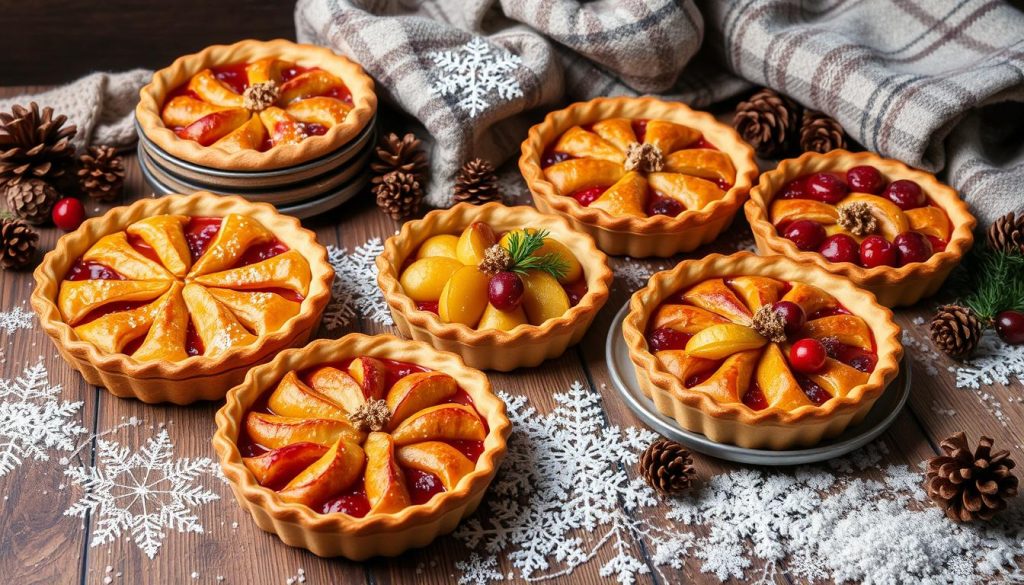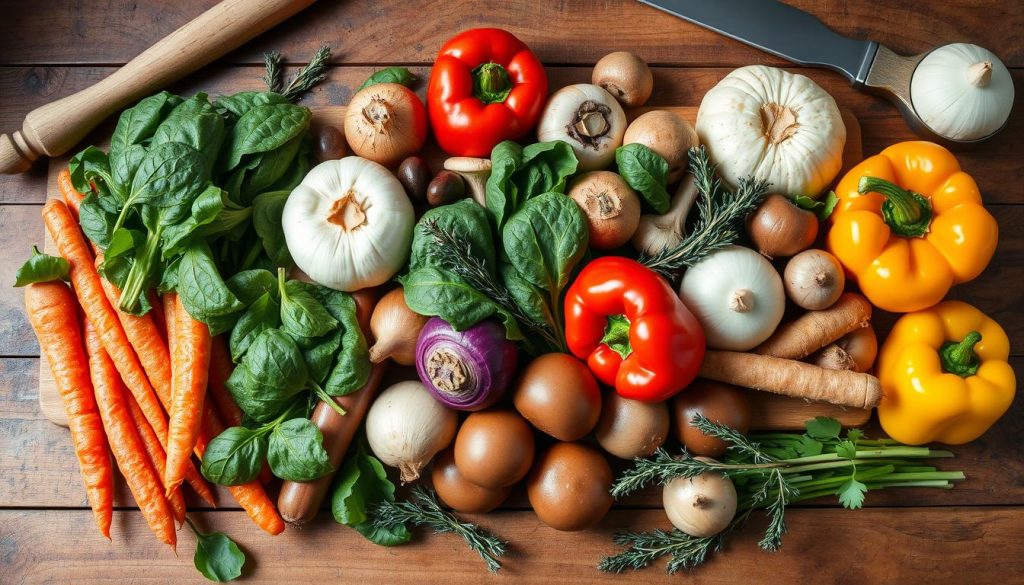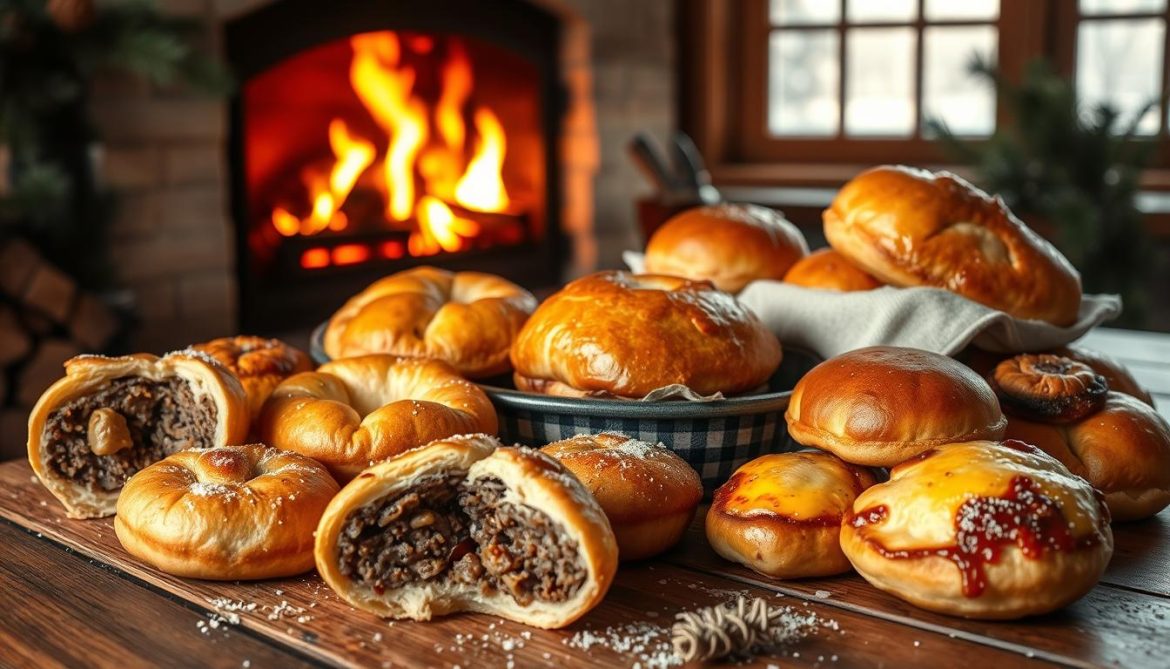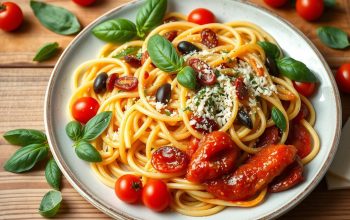Winter is the perfect time for comfort food. Homemade treats from the oven are just what we need. They turn simple ingredients into magical dishes that warm our hearts.
Hearty pastries are like edible hugs. They fill us with delicious memories. Whether you want something savory or sweet, these dishes make winter dining special.
Pastry makers know the secret to soul-warming dishes. They use passion, technique, and love. My journey through recipes has shown me that great pastries create joy.
Let’s dive into a world of flaky crusts and rich fillings. We’ll explore techniques that make cold days delicious. Our culinary adventure begins now! 🥧❄️
Essential Ingredients for Winter Pastry Making
Winter baking is an art that starts with the right ingredients. Making delicious pastries needs careful attention to each part. This turns simple ingredients into culinary wonders.
Premium Flour Selection for Perfect Crusts
Choosing the right flour is key for amazing pastry crusts. Not all flours are the same!
- Unbleached all-purpose flour: Ideal for most pastry recipes
- Pastry flour: Produces exceptionally tender crusts
- Whole wheat flour: Adds nutty depth and nutrition
Best Butter Types for Flaky Layers
Quality butter is what makes pastries truly special. European-style butter, with its high fat content, creates those flaky, melt-in-your-mouth layers.
| Butter Type | Fat Content | Best Used For |
|---|---|---|
| European-style butter | 82-86% | Croissants, puff pastry |
| American-style butter | 80% | Standard pie crusts |
| Cultured butter | 85% | Rich, tangy pastry recipes |
Seasonal Spices and Aromatics
Winter pastries shine with seasonal spices that warm the heart. Cinnamon, nutmeg, and cloves turn simple recipes into unforgettable treats.
“The secret ingredient is always love – and a pinch of the right spice!” – Baking Enthusiast
Pro tip: Toast your seasonal spices lightly before adding them. This boosts their aroma and flavor.
The History of Winter Pastry Traditions
Winter pastry history is a long and exciting journey. It spans centuries and continents. Traditional baked goods were more than just food. They were survival tools and cultural expressions for communities facing cold seasons.
Cultural pastries came from practical needs. In medieval Europe, hearty meat pies were not just tasty meals. They were also important ways to keep protein during harsh winters. Bakers found clever ways to make filling, warming dishes that could keep families going through tough months.
“Pastries are not just food; they are edible memories of generations past.” – Traditional Baker’s Wisdom
- Medieval England: Meat pies with thick crusts to retain heat
- Austrian Alps: Strudels using preserved fruits and nuts
- Scandinavian Regions: Dense rye-based pastries for extreme cold
Every region had its own winter pastry traditions. These reflected local ingredients and climate challenges. Northern communities made denser, more caloric pastries. Mediterranean cultures preferred lighter, spice-infused creations.
The history of winter baking shows human creativity. It shows how we turned simple ingredients into nourishing, comforting meals. These meals tell stories of survival, community, and culinary innovation.
Understanding Different Types of Hearty Pastries
Winter is the perfect time for comfort food, and pastries are at the top of the list. They come in many flavors, from savory to sweet. These treats warm both your body and soul.
Let’s dive into the world of pastries that make cold days special. Each type offers unique tastes and textures. They turn winter meals into a feast for the senses.
Savory Meat-Filled Options
Savory pastries are a dream come true for meat fans. You’ll find classics like:
- Beef Wellington with rich mushroom duxelles
- Chicken pot pies with creamy vegetable fillings
- Traditional shepherd’s pie with ground lamb
Vegetarian Comfort Pastries
Vegetarian pastries show that plant-based food can be just as good. They pack a punch with their flavors:
- Spinach and ricotta turnovers
- Roasted vegetable galettes
- Mushroom and butternut squash hand pies
Sweet and Rich Variations
Sweet pastries are the ultimate treat for cold days. They add joy to any occasion:
- Apple cinnamon turnovers
- Chocolate raspberry puff pastries
- Caramelized pear tarts
“Pastries are not just food; they’re edible memories waiting to be created.” – Culinary Wisdom
Every pastry has its own story, blending tradition with new ideas. Whether you prefer savory or sweet, there’s a pastry out there for you.
Basic Equipment for Cold-Weather Baking
Winter baking needs special tools and equipment. Getting the right gear can turn your kitchen into a cozy, tasty place of creativity!
Let’s look at the key baking tools for cold-weather baking. Every serious home baker needs reliable tools for making tasty treats easily.
Essential Baking Tools
- Heavy-duty rolling pin for perfect crusts
- Ceramic pie dishes for even heat distribution
- Digital kitchen scale for precise measurements
- Silicone pastry brushes
- Sturdy baking sheets
Your pastry tools are key to making delicious winter treats. A good food processor helps, but skilled hands work just as well!
“The right tools transform good baking into extraordinary culinary art.” – Professional Baker’s Wisdom
Recommended Winter Baking Equipment
| Tool | Purpose | Recommended Brand |
|---|---|---|
| Rolling Pin | Creating even pastry crusts | French Maple Wood Rolling Pin |
| Pastry Brush | Egg wash and butter application | OXO Silicone Pastry Brush |
| Pie Dish | Baking perfect pies | Emile Henry Ceramic Pie Dish |
Pro tip: Invest in quality baking equipment that will last through many delicious winter seasons!
Winter baking is about warmth and joy in your kitchen. With these essential tools, you’ll make incredible treats that warm everyone’s heart – just like your perfectly baked pastries!
Making the Perfect Flaky Pastry Dough
Creating flaky pastry dough is an art that needs precision and technique. It also requires a bit of culinary magic. Let me share the secrets to making pastry that will impress everyone!
Cold Baking Techniques That Transform Your Dough
Temperature control is key to making flaky pastry dough. Cold baking techniques are your secret. Here’s why temperature is important:
- Keep all ingredients refrigerator-cold
- Chill your mixing bowl and utensils
- Work quickly to prevent butter from melting
Mastering Dough Lamination
Dough lamination is the technique that creates those amazing layers in your pastry. It’s like making delicate butter-filled sheets that puff up beautifully when baked.
- Start with cold, cubed butter
- Fold dough multiple times to create layers
- Maintain consistent, cool temperature
The Critical Role of Pastry Resting
Pastry resting is crucial, not just a suggestion! It lets gluten relax and butter firm up. This ensures a tender, flaky texture.
“Patience is the secret ingredient in perfect pastry making” – Pastry Chef wisdom
Pro tip: Always rest your dough in the refrigerator for at least 30 minutes between folding and before final baking. This simple step can make your pastry go from good to phenomenal!
Warming Spice Combinations for Winter
Winter baking is magical with the right winter spices. Mixing the perfect blend turns simple pastries into unforgettable treats. These treats warm both your body and soul.
Exploring seasonal flavors makes winter pastries stand out. The right spices can take your baking from good to amazing!
Classic Winter Spice Combinations
- Cinnamon and Cardamom: A heavenly duo that brings warmth and depth
- Nutmeg and Clove: Rich, intense flavor perfect for sweet treats
- Ginger and Allspice: Adds a zesty kick to both savory and sweet pastries
“Spices are the soul of winter baking – they tell a story in every bite!” – Pastry Chef Recommendation
| Spice Blend | Flavor Profile | Best Used In |
|---|---|---|
| Classic Winter Mix | Warm, Sweet, Aromatic | Apple Pies, Fruit Tarts |
| Savory Herb Blend | Earthy, Robust | Meat Pies, Vegetable Pastries |
| Exotic Spice Combination | Complex, Intense | Experimental Pastry Creations |
Making your own spice blends is an art. Begin with small amounts and try different mixes! Mix ground cinnamon, fresh grated nutmeg, and a pinch of cardamom to create a unique blend. Your pastries will be unforgettable.
Pro tip: Keep your homemade spice blends in airtight containers. Store them away from direct sunlight. This helps keep their flavors and aromas strong.
Classic Meat Pie Preparations
Winter is the perfect time for hearty meals that warm our hearts. Meat pies are the ultimate comfort food, offering rich flavors and satisfying textures.
Making the perfect meat pie takes passion, skill, and the right ingredients. Let’s dive into some delicious meat pie variations to make your winter meals special.
Beef and Root Vegetable Pie Mastery
A beef and vegetable pie is the epitome of comfort food. The secret to a great filling is using top-notch chuck roast and adding seasonal root vegetables.
- Select well-marbled chuck roast for maximum flavor
- Incorporate carrots, parsnips, and potatoes for texture
- Use red wine to enhance the meat’s natural richness
Chicken and Mushroom Pie Delights
Looking for something lighter? A chicken mushroom pie offers amazing flavor. Wild mushrooms make this dish truly special.
| Ingredient | Quantity | Preparation Tip |
|---|---|---|
| Chicken Breast | 1.5 lbs | Cut into uniform cubes |
| Mixed Mushrooms | 8 oz | Sauté until golden brown |
| Fresh Thyme | 2 tbsp | Chop finely for intense aroma |
Traditional Shepherd’s Pie Variations
Shepherd’s pie is a canvas for creative cooks. Traditional recipes welcome personal twists that make each version unique.
“The beauty of shepherd’s pie lies in its adaptability and comfort-giving nature.” – Culinary Traditions Cookbook
- Classic lamb-based recipe
- Sweet potato topping alternative
- Vegetarian lentil variation
Whether you’re making a beef and vegetable pie, trying a chicken mushroom pie, or reinventing shepherd’s pie, remember. Love is the most important ingredient in any meat pie.
Sweet Fruit-Filled Winter Pastries
Winter desserts come alive with the magic of fruit pies. They warm both heart and soul. These sweet pastries turn simple ingredients into extraordinary culinary experiences. They brighten even the coldest days.

Let’s explore the delightful world of winter fruit-filled pastries. They will make your kitchen smell absolutely incredible!
- Classic Apple Pie with Caramel Drizzle
- Spiced Pear Galette
- Mixed Berry Hand Pies
- Rustic Winter Fruit Tarts
Creating the perfect winter desserts requires understanding fruit selection and pastry techniques. Frozen berries can be absolute game-changers during these chilly months. They provide rich flavors and vibrant colors.
| Fruit Type | Winter Pastry Pairing | Flavor Profile |
|---|---|---|
| Apples | Classic Pie | Sweet, Slightly Tart |
| Pears | Spiced Galette | Soft, Delicate |
| Mixed Berries | Rustic Hand Pies | Tangy, Bright |
“The secret to amazing fruit pies is using seasonal, high-quality ingredients and letting each flavor shine!” – Baking Enthusiast
Pro tip for winter dessert lovers: Always pre-cook extra juicy fruits to prevent soggy pastry bottoms. A quick sauté or light roasting concentrates flavors and reduces moisture.
Tips for Achieving Golden-Brown Crusts
Making the perfect pastry is more than just mixing ingredients. The golden-brown crust is what makes a pastry truly special. It turns simple treats into works of art.
To get that perfect golden crust, you need precision and some tricks up your sleeve. Let’s explore the key techniques to improve your pastry skills.
Mastering the Egg Wash
The egg wash is your key to a stunning golden crust. Different egg wash methods can change your pastry’s look:
- Whole Egg Wash: Creates a shiny, golden finish
- Egg Yolk Wash: Produces a deep, rich golden color
- Egg White Wash: Gives a subtle, glossy sheen
- Milk or Cream Wash: Offers a softer, more muted finish
Baking Temperature Guidelines
Finding the right baking temperature is key for perfect pastry. Here’s a quick guide to help you get it right:
| Pastry Type | Initial Temperature | Reduced Temperature | Total Baking Time |
|---|---|---|---|
| Puff Pastry | 425°F | 375°F | 25-30 minutes |
| Pie Crust | 425°F | 350°F | 35-45 minutes |
| Savory Pastries | 400°F | 350°F | 30-40 minutes |
“The difference between a good pastry and a great one is often just a matter of temperature and technique.” – Professional Baker’s Wisdom
Pro tip: An oven thermometer is a game-changer. It ensures your oven is at the right temperature for perfect crusts every time.
Remember, practice makes perfect. Don’t get discouraged if your first few attempts aren’t perfect. Each pastry is a chance to learn and get better!
Make-Ahead and Freezing Methods
Busy home bakers, rejoice! Make-ahead pastries are your secret weapon for delicious treats without daily stress. Freezing pastry dough is a game-changing technique that saves time and preserves the quality of your baked goods.
Batch baking allows you to prepare multiple pastries in advance, giving you more flexibility in the kitchen. Let’s explore the best strategies for preparing and storing your favorite pastry creations.
Freezing Pastry Dough: Essential Tips
- Wrap raw dough tightly in plastic wrap
- Place wrapped dough in a freezer-safe bag
- Label with the date and type of pastry
- Store for up to 3 months
When you’re ready to bake, thaw the dough slowly in the refrigerator overnight. This gradual process helps maintain the delicate texture and prevents moisture buildup.
| Pastry Type | Raw Freeze Time | Baked Freeze Time |
|---|---|---|
| Pie Crust | 3 months | 2 months |
| Puff Pastry | 2 months | 1 month |
| Shortcrust | 3 months | 2 months |
“Preparation is the key to stress-free baking!” – Pastry Chef Emily Rodriguez
Pro tip for make-ahead pastries: Always cool completely before freezing to prevent condensation. Wrap individual portions separately for easier thawing and serving.
Batch Baking Strategies
- Prepare multiple batches of dough at once
- Portion and freeze individual components
- Create a weekly baking prep schedule
Remember, freezing pastry dough doesn’t compromise quality when done correctly. Your future self will thank you for the delicious, homemade treats waiting in the freezer!
Seasonal Fruit Selection for Winter Baking
Winter brings a special selection of fruits that make baking a fun adventure. As it gets colder, bakers can try many winter fruits. These fruits add flavor and richness to desserts.
Winter fruits have strong flavors and are very versatile. Baking with them becomes an art. Knowing how to pick and use these fruits is key.
Apple and Pear Combinations
Creating great apple and pear desserts needs knowing about fruit types. Some top pairings are:
- Granny Smith with Honeycrisp apples for balanced tartness
- Bosc and Anjou pears for complementary textures
- Mixing golden and red apple varieties for visual appeal
These fruits make pastries amazing, turning simple recipes into special treats.
Berry Preservation Techniques
Preserved berries can make winter baking better when fresh berries are hard to find. Here are some ways to preserve berries:
- Freezing berries at peak ripeness
- Creating homemade berry compotes
- Oven-drying cranberries for intense flavor
| Winter Fruit | Best Baking Use | Flavor Profile |
|---|---|---|
| Granny Smith Apples | Pies and Tarts | Tart and Crisp |
| Bosc Pears | Galettes | Buttery and Smooth |
| Frozen Cranberries | Scones and Muffins | Tangy and Bright |
Pro tip: Always select firm, unblemished fruits for the best baking results!
“Winter fruits are nature’s sweet gift to bakers, waiting to be transformed into delicious creations.” – Culinary Enthusiast
Savory Vegetable Filling Ideas
Winter is the perfect time for hearty vegetarian pies. They warm our bodies and souls. Making delicious vegetable pastries is an art. It turns simple ingredients into amazing dishes.

Let’s explore some tasty savory fillings for your pies. The key is to pick strong vegetables for deep flavors.
- Roasted Butternut Squash with Sage: A creamy, luxurious filling packed with winter warmth
- Mushroom and Caramelized Onion: An umami-rich combination that screams comfort
- Spinach and Feta: The classic Mediterranean-inspired vegetable pastry filling
When making vegetable fillings, controlling moisture is key. I suggest roasting or sautéing veggies first. This removes extra liquid that could ruin your pastry crust.
| Vegetable | Preparation Method | Recommended Cheese Pairing |
|---|---|---|
| Cauliflower | Roast with curry spices | Aged cheddar |
| Root Vegetables | Slow-roast with rosemary | Goat cheese |
| Eggplant | Grill and season | Ricotta |
“Great vegetable pastries are about balance – texture, flavor, and love!” – Chef Elena Rodriguez
Pro tip: Always season your vegetable fillings well. A bit of fresh herbs or smoked paprika can make a simple filling exciting!
Pairing Pastries with Hot Beverages
Winter is the perfect time for cozy pastry and drink pairings. These combinations warm our bodies and souls. They turn simple moments into special culinary experiences.
Now, let’s dive into some amazing tea and pastries pairings for winter:
- Earl Grey Tea: Goes great with fruit-filled pastries, enhancing citrus notes
- Spicy Chai: Perfect for cinnamon-rich pastries, with its warm, aromatic taste
- Green Tea: Pairs well with light, fruity tarts
Coffee and Desserts: A Warm Embrace
Coffee lovers, rejoice! The right coffee can make your pastry experience even better. Dark roast coffee pairs well with chocolate pastries. A creamy latte complements caramel and nutty flavors.
Mulled Wine Magic
For the adventurous, mulled wine is a unique pairing option. This spiced wine complements winter pastries with its complex flavors. It balances sweet and robust notes.
“A perfect pastry deserves an equally perfect drink companion.” – Pastry Enthusiast
When picking your pastry and drink pairings, think about flavor intensity. Light pastries need gentle drinks. But bold, spiced pastries can handle stronger drinks.
Troubleshooting Common Winter Baking Issues
Winter baking can be tricky, but with the right techniques, you’ll conquer those chilly kitchen challenges! Let’s dive into some common baking problems that crop up during the cold months and how to solve them like a pro.
“Baking is about precision, but winter adds an extra layer of complexity to our favorite recipes!” – Pastry Chef’s Wisdom
Moisture Management in Winter Baking
Cold weather brings unique challenges to pastry making. The dry winter air can dramatically affect your dough’s consistency. Here are some winter baking tips to keep your pastries perfect:
- Check humidity levels in your kitchen
- Use slightly more liquid in dry environments
- Cover dough while resting to prevent moisture loss
Common Pastry Pitfalls and Solutions
| Baking Problem | Solution |
|---|---|
| Soggy Bottom Crusts | Pre-bake crust, use egg wash, place on lower oven rack |
| Shrinking Pie Crust | Rest dough 30 minutes before baking, avoid stretching |
| Uneven Baking | Rotate pan midway, use oven thermometer |
Pro tip: Winter’s lower temperatures can slow down yeast and affect dough rising. Keep your workspace warm and draft-free!
Temperature Control Tricks
Oven temperature is crucial in winter baking. Invest in an oven thermometer to ensure accuracy. Cold ingredients can take longer to mix and rise, so plan ahead and give your dough extra time.
- Warm ingredients to room temperature
- Use instant-read thermometer for precise baking
- Allow extra rising time for yeasted pastries
Don’t let winter baking problems discourage you! With these pastry troubleshooting techniques, you’ll create delicious, picture-perfect pastries that will warm up even the coldest day.
Storage Solutions for Fresh Pastries
Keeping your homemade pastries fresh is a fun challenge for home bakers. It’s not just about tossing them in a container. It’s an art that needs careful thought and skill.
Let’s explore some expert tips for keeping your baked goods fresh. These tips will help you enjoy your long-lasting pastries even more!
- Cool completely before storing – trap moisture is the enemy of crisp pastries
- Choose the right storage container based on pastry type
- Understand which pastries freeze best
- Separate cream-filled components for maximum freshness
Different pastries need different storage methods. Crisp croissants and flaky pies do well in breathable paper bags. Delicate cream puffs need airtight glass containers. My trick is to store pastry shells and fillings apart to avoid sogginess.
“The key to great pastry storage is understanding each treat’s unique characteristics.” – Pastry Chef Wisdom
Freezing can extend the life of your pastries. Wrap each pastry in plastic wrap, then foil. Most baked goods stay fresh for 1-2 months when sealed right.
| Pastry Type | Room Temperature Storage | Refrigerator Storage | Freezer Storage |
|---|---|---|---|
| Fruit Pies | 2 days | 4-5 days | 2-3 months |
| Cream Pastries | 4-6 hours | 2-3 days | Not recommended |
| Bread-Based Pastries | 2-3 days | 5-7 days | 1-2 months |
Proper pastry storage is more than just keeping them fresh. It’s about keeping that freshly baked taste we all adore. Try out these methods and find the best way to keep your favorite treats fresh!
Serving and Presentation Ideas for Winter Gatherings
Winter parties are all about making memories with beautiful pastry displays. The way you serve your treats can make the dining experience even better. A rustic wooden board can turn simple pastries into stunning centerpieces, making your dessert table feel cozy and welcoming.
When setting up your winter pastries, think about how they look as much as how they taste. Use tiered stands for hand pies and small tarts to add height and drama. A light dusting of powdered sugar on dark pastry crusts looks like winter frost. Adding fresh rosemary or thyme sprigs brings color and a unique scent to savory treats.
Try setting up themed presentation zones to tell a story. For example, a “Cozy Cabin” display could have vintage platters, pinecones, and pastries on slate tiles. For big parties, make your dessert table interactive. Use different heights, provide small serving tongs, and include cards with each pastry’s description to let guests explore and enjoy.
Great pastry presentation is about looking good and being practical. Pick serving pieces that let guests easily try your winter treats. Mix textures, heights, and unexpected garnishes to spark conversations and excitement about food.



